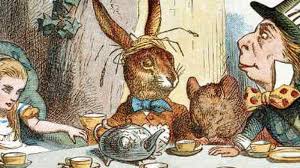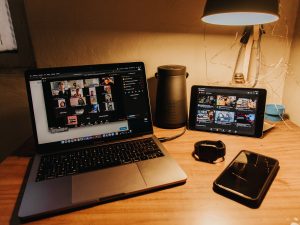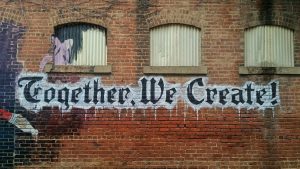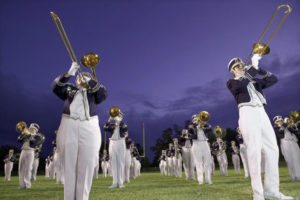We are all Alice. We’ve tumbled down the rabbit hole into a land that is utterly unfamiliar. And like Alice, we are bewildered. As we navigate the unimaginable, we will make some questionable choices (follow the white rabbit), find new friends (virtual tea parties), experiment in zooming larger and smaller (drink this/eat this), and meet some deadly foes (Red Queen and evil cohorts).
 Unlike Alice, we’re in this together. Or rather, together but apart.
Unlike Alice, we’re in this together. Or rather, together but apart.
As we grapple with the urgency of today, I think about where we go from here.
I asked you, my friends and colleagues, what will be different when we come out the other side. What will change for arts education? Thanks to all who responded to my query.
Themes of equity, virtual learning, and essential values emerge, with cautionary notes on diminished financial resources and shifting educational imperatives.
Spotlight on Equity
Some districts have turned to online instruction readily, while others are spending their precious resources in feeding the children. Access to devices and secure internet connections highlight inequities in high poverty and rural districts.
Will equity disparities prompt states and districts to demand technology purchases over investments in pedagogy and a well-rounded education? We need to be vigilant as these conversations unfold.
This extended school closure period has only heightened the reality of equity issues in arts resources and opportunities, and I suspect attention to this matter will only intensify once schools reopen. Entangled in this reality are items pertaining to funding, staffing, policy, and pedagogy. ~Fine Arts Supervisor
Value of Virtual Learning
Most respondents believe that some type of virtual learning is here to stay. And that’s largely a good thing in that it challenges our preconceived notions of what arts instruction “should” look like. A new focus on deeper learning and creativity is hopeful to many.

A major shift has occurred that opens up new possibilities for individualized learning guided by teacher/learning managers; large group experiences may come in cycles with other learning and students have the opportunity for deeper learning through creative teaching that supports the larger group experiences…. ~Mary Luehrsen, NAMM
… we are entering into a new age where the best of both education platforms will be merged and blended together and using the best of what both have to offer (real and virtual) to create even greater excitement and engagement for students, educators and families. ~David Dik, Young Audiences
The future will favor the nimble. Witness the speed that organizations, school districts, teachers, and artists have pivoted to virtual formats. The future will also favor those most open to change and willing to consider a range of possible futures.
 … I truly believe that what and how music educators teach, will shift. …The very definition of music education has quickly expanded to include student generated content and constructed knowledge that expands beyond performance, which in turn will lead to lifelong learning and independent musicianship. ~Anne Fennell, San Diego Unified School District
… I truly believe that what and how music educators teach, will shift. …The very definition of music education has quickly expanded to include student generated content and constructed knowledge that expands beyond performance, which in turn will lead to lifelong learning and independent musicianship. ~Anne Fennell, San Diego Unified School District
… I am hoping it [digital resource development] will drive teacher preparation to also include social and emotional learning … by including activities that drive social understanding and [openness to] change. ~Coordinator for Performing Arts
Vigilance Required 
We know historically what happens to the arts in times of diminished resources. Many speak about threats to funding that may impact staffing levels, pre-professional programs, pedagogy, partnerships, and availability of instructional resources.
Post-COVID 19 changes to public education are inevitable. In the short term, we know that Federal dollars will not be enough to backfill shrinking coffers at the local level. And more immediately, it is likely that districts will have increased flexibility in how to spend Federal dollars, perhaps hindering the arts.
Similarly, private philanthropy may shift resources. Increased flexibility or operational support may be beneficial for arts nonprofits. However, arts funding may move down the priority list in favor of basic community needs.
Right about now I remind myself to take the long view and appreciate our progress.
- The value of arts education is now (mostly) universally accepted.
- We can point to major policy victories with ESSA and Title IV-A funding.
- Partnerships with community nonprofits are more robust with a community-based approach.
- We know more about how the arts intersect with STEM and social emotional learning.
- We are embracing media arts and contemporary artistic genres.
Remember all this in the days ahead.
Feeding Our Souls
Finally, I can always count on my longtime friend and colleague Joe Landon to address the existential question behind the question. Joe believes that when we emerge from this crisis, the world we have known and functioned in will not be something we can ‘go back’ to.
In this moment all of us are challenged to reach deep within ourselves. As we contemplate what will be different in the world, we think about what will be different for us as humans. Think of the essentials, what provides us with joy, inspiration, and a sense of continuity. Art is that thing. Creating, listening, observing, understanding art is the ultimate crucible that will sustain us in the days ahead. ~Joe Landon, former executive director, California Alliance for Arts Education
Yes, we are all Alice, tumbling into the unknown, yet we are comforted by a forged-in-fire belief in what we know will sustain us.






